You are using an out of date browser. It may not display this or other websites correctly.
You should upgrade or use an alternative browser.
You should upgrade or use an alternative browser.
[BUILD] 1176LN Rev D DIY
- Thread starter mnats
- Start date
Help Support GroupDIY Audio Forum:
This site may earn a commission from merchant affiliate
links, including eBay, Amazon, and others.
maxwall
Well-known member
- Joined
- Nov 17, 2004
- Messages
- 1,141
Can we get a consensus on which T-Attenuator is needed ?
State is currently out of stock on the attenuators with a 4-6 week lead time.
If source-ing another brand is preferred then state will locate it and get pricing.
That is if Mallory is not the preferred manufacturer here. The goal is to locate a part that will give long hassle free lifespan.
Here is a spec sheet for a three deck. Unfortunately these are Mallory which I
hope do not have the rivet coming loose issue as described by Doug Williams in a earlier posting.
Additionally I 'm checking on a two deck attenuator with State

State is currently out of stock on the attenuators with a 4-6 week lead time.
If source-ing another brand is preferred then state will locate it and get pricing.
That is if Mallory is not the preferred manufacturer here. The goal is to locate a part that will give long hassle free lifespan.
Here is a spec sheet for a three deck. Unfortunately these are Mallory which I
hope do not have the rivet coming loose issue as described by Doug Williams in a earlier posting.
Additionally I 'm checking on a two deck attenuator with State

Sorry folks, I was passing bad info and I've corrected the previous posts. Too much stuff on the shelves, too few brain cells. I had mentioned having issues with the Mallory types from Leeds, and it was actually the Clarostat types that have the riveted shaft part issue. I have used the Mallory types as used pieces and not been terribly impressed with them, I have not used new Mallory pieces. Sorry for the confusion.
ruairioflaherty
Well-known member
[quote author="maxwall"]
State is currently out of stock on the attenuators with a 4-6 week lead time.
[/quote]
4 to 6 weeks does not seem too bad to me. Can everyone honestly say they'll have all of the other details on their Rev Ds finished in 6 weeks? :grin:
Did you get pricing info Maxwall? Also does anyone know the lead time on the PEC part?
As I mentioned before I have some of the NOS Mallorys from Leeds and I would rather use either the PEC or State versions. The Mallorys are wirewound and hence have a pretty rough feel. The main benefit of the wirewound is the higher wattage which isn't a benefit that most of us need in this context.
Cheers,
Ruairi
State is currently out of stock on the attenuators with a 4-6 week lead time.
[/quote]
4 to 6 weeks does not seem too bad to me. Can everyone honestly say they'll have all of the other details on their Rev Ds finished in 6 weeks? :grin:
Did you get pricing info Maxwall? Also does anyone know the lead time on the PEC part?
As I mentioned before I have some of the NOS Mallorys from Leeds and I would rather use either the PEC or State versions. The Mallorys are wirewound and hence have a pretty rough feel. The main benefit of the wirewound is the higher wattage which isn't a benefit that most of us need in this context.
Cheers,
Ruairi
dissonantstring
Well-known member
hi guys,
i'm not in on this group buy, but ruairi is correct. i'd just like to pass on my opinion having experience with the PEC, Mallory and Purple Audio (States) versions of the T600 attenuators.
The States have the best feeling (smooth with just a touch of resistance), PEC is second best, but similar to the States, just a little less smooth and the Mallory having the least likable feel (IMHO) being wirewound it feels kind 'scratchy' not in sound, just feel.
I can't comment on reliability as I've only had my two Rev.Ds working for less than a year.
just an opinion before you dive into a group buy of these attenuators.
regards,
grant
i'm not in on this group buy, but ruairi is correct. i'd just like to pass on my opinion having experience with the PEC, Mallory and Purple Audio (States) versions of the T600 attenuators.
The States have the best feeling (smooth with just a touch of resistance), PEC is second best, but similar to the States, just a little less smooth and the Mallory having the least likable feel (IMHO) being wirewound it feels kind 'scratchy' not in sound, just feel.
I can't comment on reliability as I've only had my two Rev.Ds working for less than a year.
just an opinion before you dive into a group buy of these attenuators.
regards,
grant
Echo North
Well-known member
[quote author="ruairioflaherty"]Also does anyone know the lead time on the PEC part?
Ruairi[/quote]
5-6 weeks ARO
-Mike
Ruairi[/quote]
5-6 weeks ARO
-Mike

$15.98
$16.98
Gikfun Upgraded USB Mini Amplifier Electronic Transparent Stereo Speaker Box Sound Amplifier DIY Kit for Arduino EK1918
Gikfun_Official_Store
I found a dead Clarostat wirewound type I opened up, so will take and post pics of the construction soon. It is theoretically possible to repair them I suppose, and at the going price, possibly practical to try doing so.
buschfsu
Well-known member
+1 for a group buy
Guts of the Clarostat type. This was NOS from Leeds. The small riveted piece seen between the decks ties the two 'handle bars' of the two decks together so they rotate as one. This riveted piece is broken. The 'handle bars' slide right out, so it would be feasible to fabricate a replacement assembly and put these back together. The two joined decks do have a joint shaft.
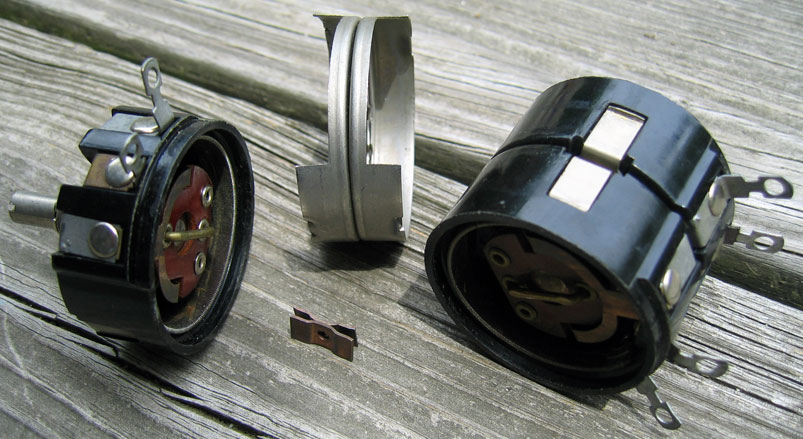
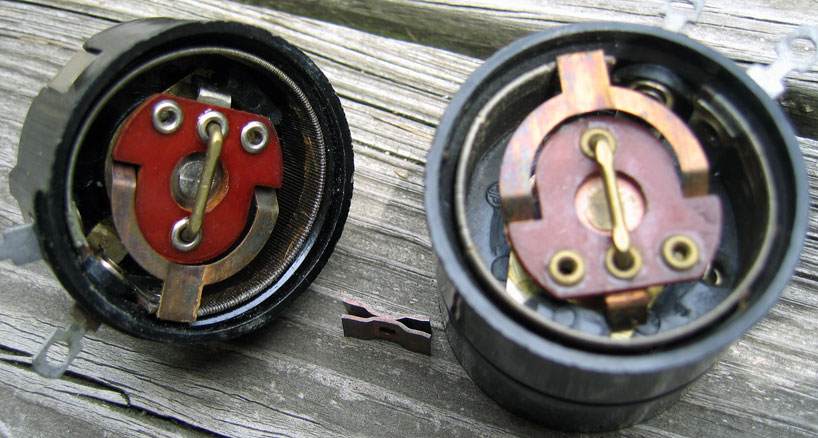


maxwall
Well-known member
- Joined
- Nov 17, 2004
- Messages
- 1,141
Doug,
Nice work and photo's - thanks.
Here is a diagram of a 1176 actual 2 deck T-Attenuator. I reversed an actual 1176 on the bench using an authentic unit. I traced the wiring to the block terminators from the attenuator and this is how its done. I measured both deck pots and resistors to get measured values. The second unit I tested had very different pot values (D1- CCW 265K) and (D2 -CW 25k ) I think one of them is either bad or massively out of spec. R2 and R3 actual ~ 620 ohm.
Strange, I thought the two deck pots would be 1K each, quite surprised compared to the three deck attenuator. The dual ganged pot has one CCW (rev log) and one CW (log) pot ganged together. Their AB brand J type pots.
I'm hoping someone here might know the actual pot values. The 1176 manual does not give the values of R1A or R1B ( omitted !!! ).
I can supply photo's if anyone is interested.
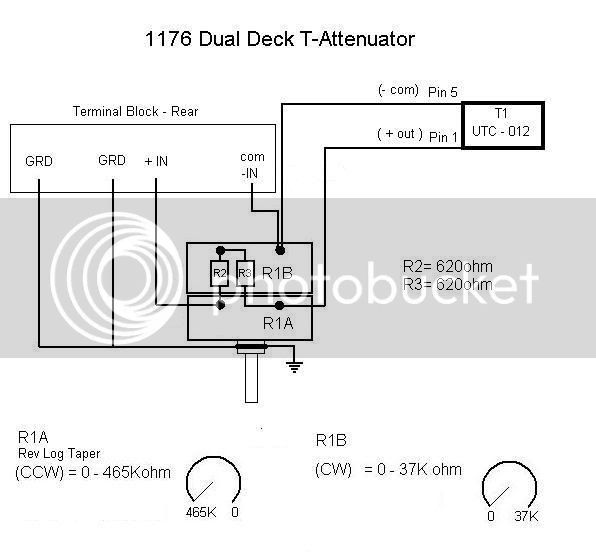
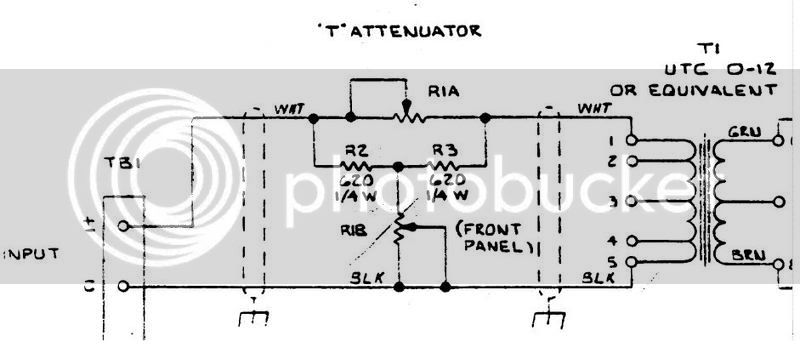
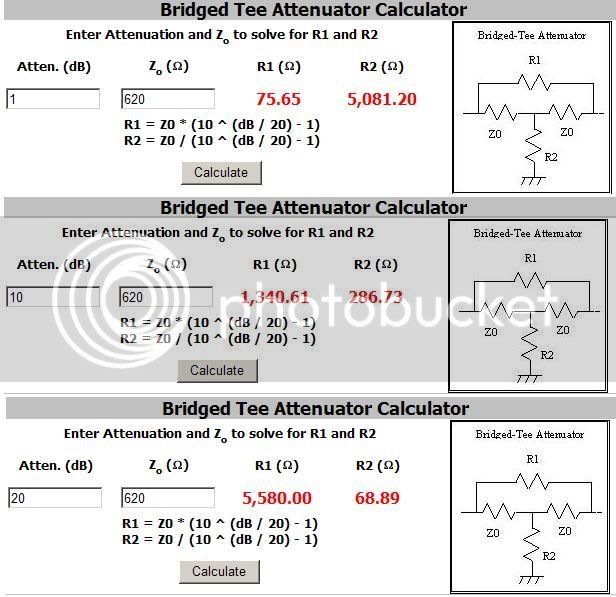
Nice work and photo's - thanks.
Here is a diagram of a 1176 actual 2 deck T-Attenuator. I reversed an actual 1176 on the bench using an authentic unit. I traced the wiring to the block terminators from the attenuator and this is how its done. I measured both deck pots and resistors to get measured values. The second unit I tested had very different pot values (D1- CCW 265K) and (D2 -CW 25k ) I think one of them is either bad or massively out of spec. R2 and R3 actual ~ 620 ohm.
Strange, I thought the two deck pots would be 1K each, quite surprised compared to the three deck attenuator. The dual ganged pot has one CCW (rev log) and one CW (log) pot ganged together. Their AB brand J type pots.
I'm hoping someone here might know the actual pot values. The 1176 manual does not give the values of R1A or R1B ( omitted !!! ).
I can supply photo's if anyone is interested.



edanderson
Well-known member
here's the deal. the two decks are both what is sometimes called a "dB" taper, which is a very unusual type of modified log. instead of each pot reaching 50% of the total resistance at 50% rotation like a linear, or 10% resistance at 50% rotation like a log pot, it is much less, like 2% resistance at 50% rotation. if you take a bunch of points and plot them, what you'll see is that the value stays quite low (almost like a linear) until very near the end and then shoots up. this is also why the end values you measure will be quite different from unit to unit. the exact value at each end doesn't matter that much, only that it should be "alot more" than the value in the middle.
i've looked around, and i doubt you'll be able to find anyone willing to make such an oddball taper pot these days (except for PEC, who are already doing it), and certainly not in the quantities that you're looking for. but good luck anyway; it would be great if you did find something.
ed
i've looked around, and i doubt you'll be able to find anyone willing to make such an oddball taper pot these days (except for PEC, who are already doing it), and certainly not in the quantities that you're looking for. but good luck anyway; it would be great if you did find something.
ed
CJ
Well-known member
daven
l
l
Grooveteer
Well-known member
Hi Guys,
I'm having problems getting the 2N3708's. RS does not seem to have them and the guy in my local shop said that they're no longer available :?:
He recommened using BC550B (although they have a different pin out)
I've looked at the datasheets, but I'm such a noob... Would BC550B be ok to use?
Thanks!
Cheers,
G.
I'm having problems getting the 2N3708's. RS does not seem to have them and the guy in my local shop said that they're no longer available :?:
He recommened using BC550B (although they have a different pin out)
I've looked at the datasheets, but I'm such a noob... Would BC550B be ok to use?
Thanks!
Cheers,
G.
skipwave
Well-known member
Mouser has them, but shipping is likely prohibitive.
http://www.mouser.com/Search/Refine.aspx?Ntt=610-2N3707
http://www.centralsemi.com/PDFs/products/2n3707-3711.pdf
At a glance BC550B would make a fine sub. This design is not asking very much of them, and the 3707 was probably selected for noise performance more than anything else.
http://www.mouser.com/Search/Refine.aspx?Ntt=610-2N3707
http://www.centralsemi.com/PDFs/products/2n3707-3711.pdf
At a glance BC550B would make a fine sub. This design is not asking very much of them, and the 3707 was probably selected for noise performance more than anything else.
Nele
Well-known member
you can get them on ebay for not that much...
I've posted some tests that I did on the output transformer that Ed will be offering for this project on my Rev D page.
Grooveteer - have a look at the page as well to see another substitute transistor you can use instead of the 2N3707/8. Should be able to find it anywhere.
Grooveteer - have a look at the page as well to see another substitute transistor you can use instead of the 2N3707/8. Should be able to find it anywhere.
maxwall
Well-known member
- Joined
- Nov 17, 2004
- Messages
- 1,141
Matching Q1 and Q11 may ensure accurate tracking of the gain reduction metering circuit that reflect the actual behavior of the audio gain reduction. However, keep in mind that the meter circuit provides a visual indication of the audio signal, so accurate matching of these parts might not be essential. You may wish to select FETs for a particular threshold range.
this would be the 2N5457 fets
Is there a easy test jig for doing this , I would like I try it : how is this accomplished ?
what threshhold is best ?
[quote author="maxwall"]
this would be the 2N5457 fets
Is there a easy test jig for doing this , I would like I try it : how is this accomplished ?[/quote]
Never had a problem calibrating the meter circuit of any of my builds and I don't recall ever matching but I do remember someone mentioning having problems with it before. There must have been a reason why I stuck it on that page...
Anyway, the search function is your friend:
http://www.groupdiy.com/index.php?topic=55736#55736
Make sure you check out PRR's comments a little further down as well. Where matching really seems to help is if you're trying to build a stereo pair. Of course you'll worry most about the pair at the inputs rather than the ones in the meter circuit.
this would be the 2N5457 fets
Is there a easy test jig for doing this , I would like I try it : how is this accomplished ?[/quote]
Never had a problem calibrating the meter circuit of any of my builds and I don't recall ever matching but I do remember someone mentioning having problems with it before. There must have been a reason why I stuck it on that page...
Anyway, the search function is your friend:
http://www.groupdiy.com/index.php?topic=55736#55736
Make sure you check out PRR's comments a little further down as well. Where matching really seems to help is if you're trying to build a stereo pair. Of course you'll worry most about the pair at the inputs rather than the ones in the meter circuit.
Similar threads
- Replies
- 5
- Views
- 605
- Replies
- 2
- Views
- 566

















![Soldering Iron Kit, 120W LED Digital Advanced Solder Iron Soldering Gun kit, 110V Welding Tools, Smart Temperature Control [356℉-932℉], Extra 5pcs Tips, Auto Sleep, Temp Calibration, Orange](https://m.media-amazon.com/images/I/51sFKu9SdeL._SL500_.jpg)














